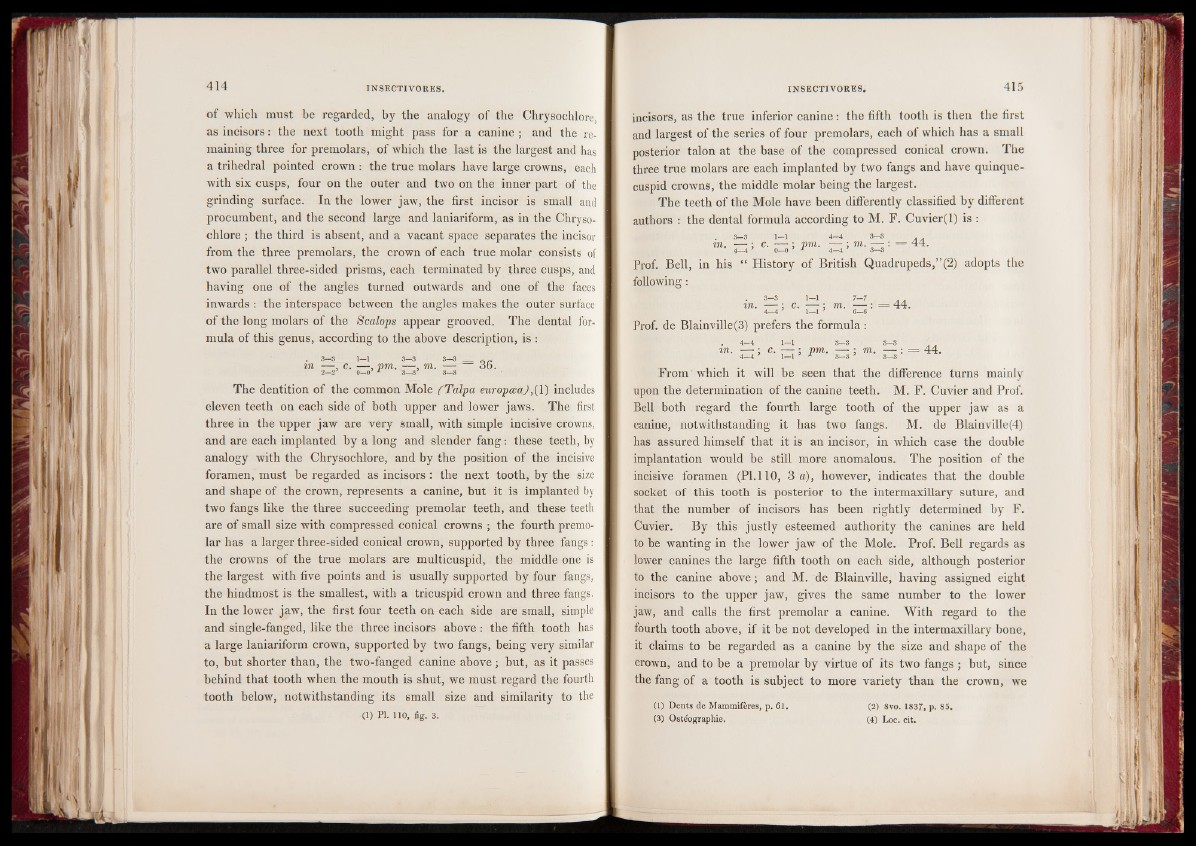
of which must be regarded, by the analogy of the Chrysochlore
as incisors : the next tooth might pass for a canine ; and the remaining
three for premolars, of which the last is the largest and has
a trihedral pointed crown : the true molars have large crowns, each
with six cusps, four on the outer and two on the inner part of the
grinding surface. In the lower jaw, the first incisor is small and
procumbent, and the second large and laniariform, as in the Chrysochlore
; the third is absent, and a vacant space separates the incisor
from the three premolars, the crown of each true molar consists of
two parallel three-sided prisms, each terminated by three cusps, and
having one of the angles turned outwards and one of the faces
inwards : the interspace between the angles makes the outer surface
of the long molars of the Scalops appear grooved. The dental formula
of this genus, according to the above description, is :
in 23_—23 } c. —1—1 , pm. m3—3 m. 0—0’ r 3—3 '
3—3
3—3 B 36.
The dentition of the common Mole (Talpa europcsaj ,(1) includes
eleven teeth on each side of both upper and lower jaws. The first
three in the upper jaw are very small, with simple incisive crowns,
and are each implanted by a long and slender fang: these teeth, by
analogy with the Chrysochlore, and by the position of the incisive
foramen, must be regarded as incisors : the next tooth, by the size
and shape of the crown, represents a canine, but it is implanted by
two fangs like the three succeeding premolar teeth, and thesn teeth
are of small size with compressed conical crowns ; the fourth premolar
has a larger three-sided conical crown, supported by three fangs:
the crowns of the true molars are multicuspid, the middle one is
the largest with five points and is usually supported by four fangs,
the hindmost is the smallest, with a tricuspid crown and three fangs.
In the lower jaw, the first four teeth on each side are small, simple
and single-fanged, like the three incisors above : the fifth tooth has
a large laniariform crown, supported by two fangs, being very similar
to, but shorter than, the two-fanged canine above; but, as it passes
behind that tooth when the mouth is shut, we must regard the fourth
tooth below, notwithstanding its small size and similarity to the
(1) Pi. no, fig. 3.
incisors, as the true inferior canine : the fifth tooth is then the first
and largest of the series of four premolars, each of which has a small
posterior talon at the base of the compressed conical crown. The
three true molars are each implanted by two fangs and have quinque-
cuspid crowns, the middle molar being the largest.
The teeth of the Mole have been differently classified by different
authors : the dental formula according to M. F. Cuvier(l) is :
i.n . 3——3 : c. 1——1 ; pm. 4——4 ; m.3 ——3 : = .4 .4. 4—4 > 0—0 ’ r 4—4 ’ 3—3 Prof. Bell, in his “ History of British Quadrupeds,”(2) adopts the
following:
in. — : c. [H ; ire. — 4—4 ’ 1—1 ’ 6—« Prof, de Blainville(3) prefers the formula :
= 44.
in. 4 -4
4 - 4 ’
c. —1—1 ; pm. 3 -3 l. 1—1 ’ 1 3M—3b ’: m .
3—3
3 -3 = 44.
From' which it will be seen that the difference turns mainly
upon the determination of the canine teeth. M. F. Cuvier and Prof.
Bell both regard the fourth large tooth of the upper jaw as a
canine, notwithstanding it has two fangs. M. de Blainville(4)
has assured himself that it is an incisor, in which case the double
implantation would be still more anomalous. The position of the
incisive foramen (PI. 110, 3 a), however, indicates that the double
socket of this tooth is posterior to the intermaxillary suture, and
that the number of incisors has been rightly determined by F.
Cuvier. By this justly esteemed authority the canines are held
to be wanting in the lower jaw of the Mole. Prof. Bell regards as
lower canines the large fifth tooth on each side, although posterior
to the canine above; and M. de Blainville, having assigned eight
incisors to the upper jaw, gives the same number to the lower
jaw, and calls the first premolar a canine. With regard to the
fourth tooth above, if it be not developed in the intermaxillary bone,
it claims to be regarded as a canine by the size and shape of the
crown, and to he a premolar by virtue of its two fangs ; but, since
the fang of a tooth is subject to more variety than the crown, we
(I) Dents de Mammifères, p. 61.
(3) Ostéographie.
(2) 8vo. 1837, p. 85.
(4) Loc. cit.